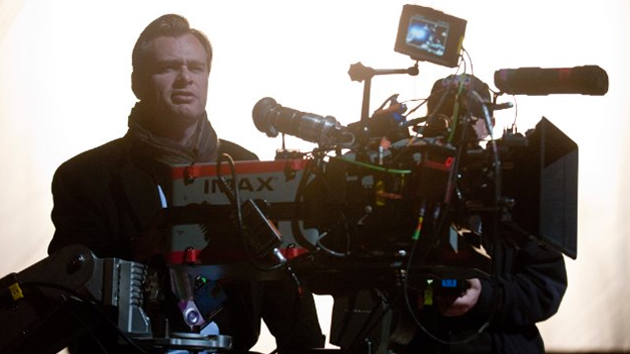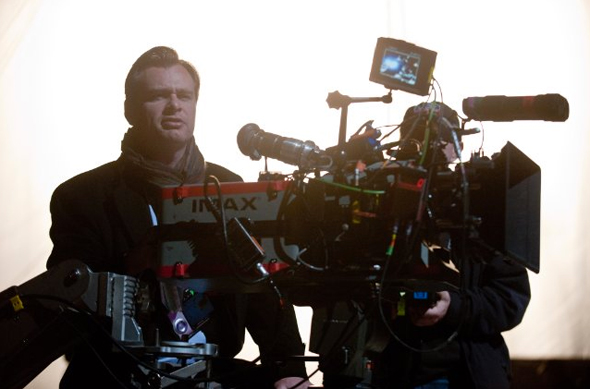The film is two weeks away from release, but yesterday the producers of The Dark Knight Rises, the last installment of Christopher Nolan's Batman/Dark Knight trilogy, dropped a nearly 50-page PDF of detailed production notes on the film's official web site. Beyond the bits of dialogue, character notes and cast bios is a surprising amount of production detail straight from the mouths of Nolan and his team. In this age of Twitter/Facebook, it's a smart move to create and widely post a heftier press packet that can be parsed out in crunchy bites in the days prior to the film's release. And at 49 pages, there's something for everyone. Here are nine interesting tidbits that prove TDKR filmmakers are at the top of their craft. (Note: The original link has mysteriously gone offline since I first downloaded it earlier today, so maybe the wide-release "press packet" wasn't meant for all eyes after all. Deadline has since posted its own watermarked version here.)
1. Nolan still cares deeply about the IMAX film format. Nolan shot roughly half the film on large-format cameras with ultra resolution 15 perf/65-millimeter film, which is why he's bullish on how the film will be presented. “It is very important to me that we show The Dark Knight Rises in the IMAX film format wherever possible," he explains. "Audiences everywhere should be assured that every presentation of the film will be of the highest standard—having benefited from the clarity and depth IMAX cameras offer."
2. More IMAX cameras and footage this time around means an even more immersive experience. “We got great results with the IMAX cameras on the last film," Nolan says. "I appreciate what it offers from the technical side, but I’m most interested in what it can give me as a storytelling tool. How can it help me pull the audience deeper into this world? IMAX provides the broadest possible canvas, creating the most immersive experience…it adds scale and broadens the tableau of the image. We learned a lot with our use of the cameras on The Dark Knight, so we were able to refine our techniques to give us better exposure and so forth. There was a lot of technical innovation, which enabled us to take it to the next level.”
3. Speaking of innovation, DP Wally Pfister shot more scenes in lower light and got to work with a better viewfinder and lens. Says Pfister, who won an Academy Award for his work on Nolan's Inception, "We spent about six months working with Panavision and IMAX to retool the viewfinder on the cameras and craft new lenses, which allowed us to shoot in very low-light conditions. With those advancements, we were able to do things we couldn’t do on the previous film.”
4. Nolan pushes the action as far as physical reality will take it, but Oscar-winning VFX supes Paul Franklin and Chris Corbould still make magic. The Dark Knight's new flying machine in this film, The Bat, is equal parts Apache attack helicopter, Osprey prop jet and Harrier jump jet, with an awful lot of moving parts. Says Chris Corbould, “The cockpit opens; the aerial flaps all operate; and it has working rotors and lights. It’s nearly 30 feet long and 17 feet wide and weighs about 3,000 pounds; it’s a big piece of machinery. We employed a variety of different methodologies to make The Bat ‘fly,’ because Chris’s mantra is he wants to do as much as possible before letting CGI take over. So we had it supported on wires, running along high lines, suspended from cranes or helicopters, and mounted on a specially constructed vehicle fitted with hydraulic controls.” In a scene at Heinz Field, home of the Pittsburgh Steelers, real exploding turf (scheduled to be replaced for the upcoming football season) and a massive platform extend the illusion of a digitally rendered chasm executed by Paul Franklin's VFX team.
5. The action continues to serve character development, not the other way around. In the words of Producer Emma Thomas, “Right from the start, Chris set out to make each of these films something that could not be categorized into any one genre. The Dark Knight Rises has all of the excitement and fun that a big summer movie ought to have. The action is huge, but the story and characters are equally, if not more, important, because it’s hard to care about all the bells and whistles if there isn’t something to engage you in an emotional way.”
6. The soundtrack's crowd-sourced experiment actually worked. Thousands of random chants, recorded and sent by normal folks from around the world via the SoundCloud app UJAM, were synched to add a signature and eerie texture to the film's soundtrack. Composer Hans Zimmer admits, “I suggested to Chris that this was a way to give something back to the fans and let them be a real part of this world. There was some question about if it would work, but it all came together beautifully.”
7. Anne Hathaway's stunt double isn't just some guy in Catwoman clothing. It turns out that pro motocross racer and stunt rider Jolene Van Vugt—the first woman (on record) to backflip a full-size dirt bike—stepped in for Hathaway during scenes when Catwoman speeds through the streets of Gotham in her Bat-Pod.
8. Actual Pittsburgh Steelers were cast in the film. In another nice touch of authenticity, the film brings 11,000 Steelers fans (as extras) to Heinz Field and drafts a few star players to the fictional footbal team, the Gotham Rogues. Pittsburgh's mayor, Luke Ravenstahl, appears as a kicker for the opposing team, the Rapid City Monuments.
9. New York City is the true heart of Gotham. New Yorkers remember when Nolan temporarily occupied Wall Street and shut down the Queensboro Bridge while filming scenes in the city last year. Those minor inconveniences have been rewarded with a higher profile for NYC this time around, even though Los Angeles, Scotland and Pittsburgh were also prominent locations. “Gotham has always drawn a lot from New York," says Nolan. "It’s a heightened version of it, but that was always the inspiration, hence the name Gotham. So I felt that we should get more of New York into this film, specifically because The Dark Knight Rises is very much about Gotham…more than the previous two films have been.” In those past two films, as some will recall, Chicago doubled as Gotham City.
Topics: Blog Films and Filmmakers Shooting Technology VFX Christopher Nolan fix IMAX film format The Dark Knight Rises Wally Pfister
Did you enjoy this article? Sign up to receive the StudioDaily Fix eletter containing the latest stories, including news, videos, interviews, reviews and more.


Thanks for teasing us with this PDF and then taking it offline. Post the copy that you downloaded! WTF!!!!???
The producers of THE DARK KNIGHT RISES took it offline after posting to their site. It was a public download this morning. Maybe we should all direct our complaints to them.
Yeah, it would be nice to see it. I’m sure they did it on purpose to see who noticed. Will you forward the copy? TL
Very nice summary of the production materials!
However, in item #5 – you wrote:
“Character continues to serve the action, not the other way around”
Actually, after reading the description for that item, I’m pretty sure you did meant it the other way around – action continues to serve the character.
You’re right. Brain burp!
The original .pdf would’ve been interesting to read. Rather than depend on an ephemeral post out of your control, perhaps you might’ve created your own copy “saved as” then posted on your own web address. Once posted, it’s open for public domain, no? Or would there have been a legal liabilities with that?
until now I had quite some respect for your site – but now I realize that you`re just a bunch of lousy wieners for not posting the alternative links to the pdf, which, btw, is totally useless public relation babble-garbage.